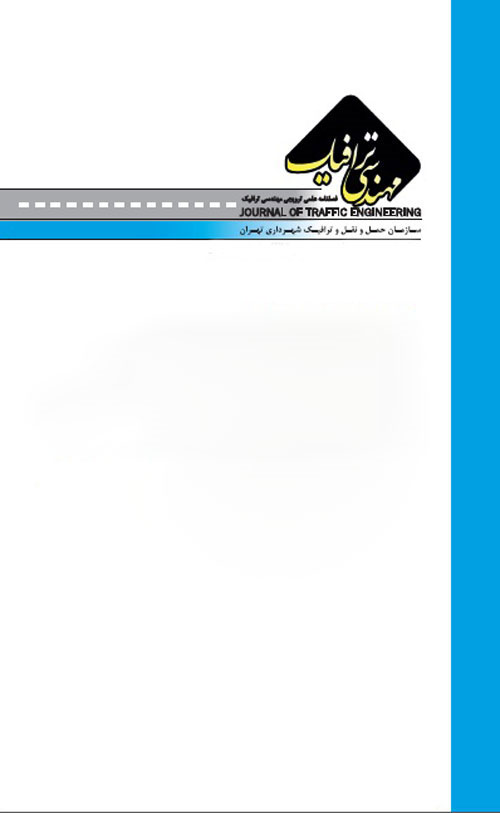فهرست مطالب

نشریه مهندسی ترافیک
پیاپی 56 (بهار 1393)
- تاریخ انتشار: 1393/03/20
- تعداد عناوین: 7
-
-
Page 5Sidewalks, spaces, reducing of traffic jam, decreasing of environmental pollution and satisfaction of pedestrians must be investigated from different point of views. The previous studies only searched about general parameters and never considered specific parameters such as: sidewalks pavement conditions, type of sidewalks, the sense of security, and the continuity of sidewalks. The aim of this study was to investigate both physical and mental situations of sidewalks. At first, the collected data from questionnaires was analyzed by applying AHP method. The second step was sensitivity analysis method to rank the importance of parameters. The obtained results showed that Sidewalks Trees and Beauty were the most significant parameters having vital roles on increasing pedestrians, satisfaction.Keywords: Sidewalks, Pedestrian, Questionnaires, AHP, Sensitivity Analysis
-
Page 13The growth of population has effects on fuel consumption and makes various problems for citizens. Optimizing the capacity of cars, parking can solve most of traffic,s conflicts. Corresponding of increasing of users we must provide more capacity to control traffic. Increasing of capacity is constructing the new streets, new parking lots or providing other suitable approaches such as system management of parking or correcting distance from parking,s facilities. This study tries to introduce one of the parameters of artificial intelligence called sequential adopting genetic algorithm to select best parking,s facility and consequently to reduce congestion of traffic.Keywords: Artificial intelligence, Congestion, Parking, capacity
-
Page 21Nowadays, development of industries and increment of urbanization which have led to population augmentation, air pollution and become a big problem. Air pollution has several negative impacts on human mind and body health and city environment. In recent years a great success in transportation technologies has been perceived. One of these technologies is utilization of electric batteries in existing internal combustion motors vehicles. Since electrical energy is a clean one, it is expected that air pollution decrease considerably by penetration of these vehicles in transportation system. In this paper, mentioned issue is scrutinized for city of Tehran. Three different scenarios with different level of penetration are considered. The results show that electric motorcycles can be used as a quick solution and electric cars can be used as an effective long-term solution for decreasing air pollution.Keywords: Electrical, Transportation, Cars, Motorcycles, Environment
-
Page 32Traffic study in node point is crucial Because of growth of population and transportation. Diamond, signalized and clover interchange are not study by experts until now. This study aimed to compare these three models of intersection and applied the AIMSUN software and field statistics. By comparing the results of this simulation, diverging diamond intersection was chosen as the best option in term of improving traffic and economic performance in city. Simulation determines that available intersection waste 6 million dollars in one year. The cost of clover interchange is 200 thousands of dollars but it will have huge construction,s cost. Diamond intersection is the best traffic option by 570 thousand dollars of cost of wasting the investment and time in one year.Keywords: Interchange, Diamond, Clover Leaf, Microscopic Traffic Simulation, Cost
-
Page 43This study examined different methods of the railway capacity for Iranian railway network. Saturation coefficients presenting by UIC 405 and UIC 406 is equal to 0.6 for mixed freight and passenger traffic. Garmsar-Bahram double-track railway and Doroud-Andimeshk single-track railway are investigated as two corridors in orderto compare different capacity methods and to analyze the saturation coefficient in Iranian network. All data are collected from train movements of mentioned corridors in 2013 year. The data analysis shows that in the crowded block sections, the capacity consumption is greater than %60 in most days of the year. According to the results of statistical analysis and different interviews of Iranian,s experts, the saturation coefficients of 0.8 and 0.75 are proposed for Iranian double-track and single-track railways.Keywords: Train, Capacity, Railway, Saturation coefficients, headway
-
Page 55Construction of residential, commercial, medical, official and other different type of complexes is symbol of land use development. Determination of trip generation rate is vital parameter for Transportation planners for conducting an Impact study. In this research a regression models show different land use trip generation rate based on collected data of users, trip behavior. A literature review expressed the importance of localizing trip generation study. Data collection and analysis methods are demonstrated and shown as standard structure. Finally results of study are compared with other countries and cities for analyzing different trip generation based on travel behavior.Keywords: Land Development, Trip Generation, Impact studies, Trip Generation Rate, Linear Regression
-
Page 66Optimizing the urban bus networks not only reduces environmental pollution but also effects on costs of transit system. In this study we examined various rapid vehicles (express buses) in terms of capacity and fuel consumption to reduce energy consumption, system costs and empty seat-minute. Our main goal is reduction of energy consumption. The results show that without increasing fleet development and average passenger waiting time, we can optimize reduction of energy consumption and empty seats.Keywords: Urban Bus Network, Energy Consumption, Optimization, Rapid Vehicles

